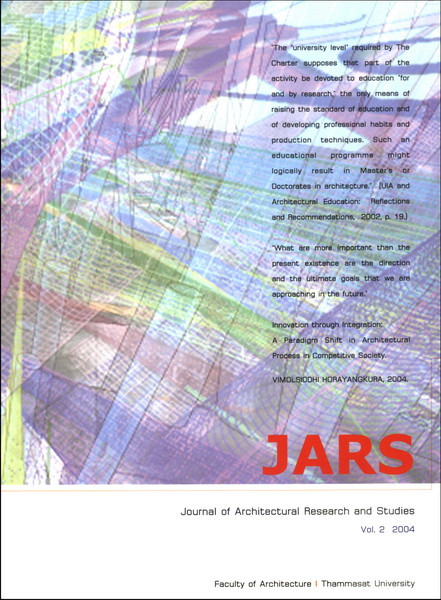Towards the Understanding of Embodied Energy in Buildings: Emergy of Construction and Demolition
Main Article Content
Abstract
This paper presents the study of embodied energy use throughout the construction and demolition as a tool to indicate embodied energy efficiency and environmental inputs of buildings and building materials in Thailand. Emergy 26 Journal of Architectural Research and Studies Volume 2 2004 Faculty of Architecture Thammasat University Analysis Technique is used to calculate the amount of energy required to make something expressed in units of the same form of energy, called Solar Emergy. And Emergy of money, called Embath has also been evaluated. The objectives are to evaluate and compare Emergy and Embath of buildings to help determining the Emergy saving and the environment benefits of buildings and building materials during construction and demolition. The method is to collect and analyze data inputs of cost and quantity from bill of quantity; BOQ of buildings: residences, schools, offices and hospitals for construction and 2 types of structure, halftimber and concrete structure for demolition. Materials during construction and demolition of each building are evaluated. This study examines all factors, which are Emergy, masses and cost, and environmental inputs to create Emergy index and environmental index as well. Four influencing factors effecting Emergy values are found: Renewable resource or structure, non-renewable resource or decoration, building system and labor. Structure is the major factor of residential buildings, schools and office buildings. Decoration is the major factor of hospital buildings. In demolition stage, structure is also the main factor. In demolition stage, Emergy value of half-timber structure buildings is the same as 7 years of energy consumption. Whereas Emergy value of concrete structure building is the same as 19-30 years of energy consumption. Therefore, structure materials should be used in as small amount as possible, especially the high transformity materials. Eventually, the environmental index suggested that using more renewable than non-renewable resource would be appropriate to the environment and the world resource. The building usable life is depend on materials, the more non-renewable resource, the longer life of the materials should be used.
Downloads
Article Details

This work is licensed under a Creative Commons Attribution-NonCommercial-NoDerivatives 4.0 International License.
All material is licensed under the terms of the Creative Commons Attribution 4.0 International (CC-BY-NC-ND 4.0) License, unless otherwise stated. As such, authors are free to share, copy, and redistribute the material in any medium or format. The authors must give appropriate credit, provide a link to the license, and indicate if changes were made. The authors may do so in any reasonable manner, but not in any way that suggests the licensor endorses you or your use. The authors may not use the material for commercial purposes. If the authors remix, transform, or build upon the material, they may not distribute the modified material, unless permission is obtained from JARS. Final, accepted versions of the paper may be posted on third party repositories, provided appropriate acknowledgement to the original source is clearly noted.
References
กรมโยธาธิการ. หลักเกณฑ์การถอดแบบหาปริมาณวัสดุเพื่อคำนวณราคากลาง. http://www.psd.go.th, [6 มีนาคม 2544].
ตารางเหล็กสำหรับผู้รับเหมาก่อสร้างและวิศวกร. พิมพ์ครั้งที่ 2, กรุงเทพ ฯ: ทีกรุ๊ฟ อ๊อฟ เอนจิเนียร์ฯ, ไม่ปรากฏปีที่พิมพ์.
บริษัท ยูเนียนแอ็สโซซิเเอทส์ จำกัด, คู่มือการประมาณการ (Estimation Manual & Building Material). พิมพ์ครั้งที่ 6, มปท. : กรุงเทพ ฯ, 2533.
พิภพ สุนทรสมัย. การประมาณราคาก่อสร้าง. พิมพ์ครั้งที่ 18, กรุงเทพ ฯ:, สมาคมสงเสริมเทคโนโลยี (ไทย-ญี่ปุ่น): 2538.
วรสัณฑ์ บูรณากาญจน์. Environmental Technology และ Green Architecture. เอกสารประกอบการสอน วิชา พัฒนาการวิชาการสถาปัตยกรรม. คณะสถาปัตยกรรมศาสตร์จุฬาลงกรณ์มหาวิทยาลัย, 2543.
วรสัณฑ์ บูรณากาญจน์.. Energy and Environment inputs in Building Operation (Condominium Case Study, Bangkok Thailand). สาระศาสตร์สถาปัตย์ 2543, คณะสถาปัตยกรรมศาสตร์จุฬาลงกรณ์มหาวิทยาลัย, 2543.
สมาคมอตสาหกรรมก่อสร้างไทย, ข่าวช่าง. ปีที่ 29 ฉบับที่ 345 มีนาคม 2544. กรงเทพ ฯ: โรงพิมพ์เดือนตุลา 2544.
Brown, L.,Harry. Energy Analysis of 108 Industrial Processes. Atlanta, GA: Fairmont Press, 1985.
Buchanan, H., Andrew, and Honey, G., Brian. Energy and Carbon Dioxide Implications of Building Construction. Energy and Buildings, 20 1994. New York: Elsevier Science, 1994.
Buranakarn, Vorasun. Evaluation of Recycling and Reuse of Building Materials Using the Emergy Analysis Method. Dissertation (Ph.D.), Department of Architecture, University of Florida, 1998.
Odum, Howard T. Environmental accounting: EMERGY and environment decision making. New York: John Wiley, 1996.
Odum, Howard T., Brown Mark T. and Brandt-Williams, Sherry. Handbook of Emergy Evaluation: A compendium of Data for Emergy Computation Issued in a Series of Folios. Folio#1 Introduction and Global Budget, May 2000. Florida: Center for Environmental Policy Environmental Engineering Sciences, 2000.
Odum, Howard T. Handbook of Emergy Evaluation: A Compendium of Data for Emergy Computation Issued in a Series of Folios. Folio#2 Emergy of Global Processes, May 2000. Florida: Center for Environmental Policy Environmental Engineering Sciences, 2000. 41 Towards the Understanding of Embodied Energy in Buildings: Emergy of Construction and Demolition Pimonmart Wankanapon
Stein, Benjamin. and Reynolds, S., John. Mechanical and Electrical Equipment for Building. 8th Edition, New York: John Wiley & Son, 1992.
Stein R., G. Architecture and Energy. Garden City, NY: Anchor Press/Doubleday, 1977.


